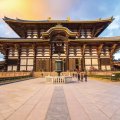TŌDAI-JI
Located in the north of Nara Park, it is one of the most famous temple complexes in Nara and Japan. Listed as a Unesco World Heritage Site, it is so large and there is so much to see that one can easily spend the afternoon there. Tōdai-ji was built in the 8th century by order of Emperor Shōmu. After a series of natural disasters, the emperor decided that every province would have a Buddhist temple and that Tōdai-ji would be built to be at the head of these temples. The emperor's political plan was to create a centralized state based on Buddhism. Construction took over 20 years, and the temple opened in 752. It held immense power during the Nara period but declined when the capital was moved to Kyoto in 794. Destroyed or burned several times, notably by the Taira clan in 1180, and rebuilt in 1195 by the monk Chōgen Sunjōbō, it was burned again in 1567 and rebuilt by Tsunayoshi Tokugawa in 1708. Its last restoration was in 1980. Originally, the Tōdai-ji included, in addition to the current buildings, 2 large pagodas with 10 and 7 floors. The Tōdaiji houses the Daibutsuden, the Buddha pavilion, and other pavilions scattered throughout a large park.
Daibutsu-den or Kon-dō. In front of the building, a stone pillar is topped by an octagonal lantern dating from the 8th century. The Daibutsu-den, which houses the gigantic bronze statue of Buddha, is 57 m long and 50 m wide. Its height is 47 meters. It is one of the largest wooden buildings in the world, yet it is only a modest reconstruction of the original building. It consists of a double roof, supported by pillars knotted together by a metal ring to support the gigantic weight (450 tons). The building was constructed in four years, from 747 to 751, at the same time as the statue. The statue itself represents Vairocana Buddha, or Resplendent Buddha. It is 15 meters high and weighs 450 tons. It is the largest statue of this Buddha in the world. It was cast in 749 with a special technique called garakuri. It was first damaged by an earthquake in 885, then in the successive fires in 1180 and 1567, but the statue was always repaired. Nevertheless, the renovations made it lose its homogeneity. Thanks to X-rays, a tooth, pearls, mirrors and swords were discovered in the knee of the statue. These are believed to be relics of the emperor Shōmu.
Nandai-mon. South Gate. It was built in 1199 and is 29 m high and 11 m deep. The building is five ken (1 ken is 182 centimeters) in length and two ken in depth. This gate, built in the Tenjiku-yō style, houses two large statues of Nio executed by Unkei and Kaikei. One has a closed mouth and the other an open mouth. It gives off an impression of powerful anger and determination. Behind the two statues are 2 lion dogs (koma-inu) executed by the Chinese sculptor Chinnakei in 1196.
Chū-mon is connected to Daibutsu-den by corridors. Near the Mirror Pond, one will notice the locations of the two pagodas, seven and ten stories high respectively.
Nigatsu-dō. Founded in 752, it was rebuilt in 1669. This hall houses two statues of Kannon, one of which is said to have been found in Ōsaka Bay by the monk Jichū. Visiting this hall is not permitted to the public.
Hokke-dō. This hall was built by Ryōben, a member of the Kegon-Shū sect in 733. Sculptures dating from the 8th to the 14th centuries can be seen here.
Shōrō (or belfry). Built in 1239, it contains the largest clapperless bell in Japan.
Kaisan-dō (Founder's Hall). Built in 1019 and rebuilt in 1250 in the Tenjiku-yō style. It contains a statue of Ryōben which is usually only visible on December 16.
Kaidan-in (Ordination Hall). It contains the clay Shi-Tennō, guardians of the Four Directions and dating from the Tempyō period, during the reign of Emperor Shōmu, from 729 to 749.
Shōsō-in (imperial treasure). Located north of Daibutsu-den, the building was constructed in 760 in the azekura-zukuri (kura: granaries) style. The building is supported by forty pillars with a height of 2.50 meters. The roof is in Yosemune style and covered with tiles. Nowadays, the treasure is kept in Nara National Museum. It is exhibited every year from the end of October to the beginning of November.
Tegai-mon. This is one of the oldest buildings in the temple as it dates back to 752. According to legend, walking in front of this building is supposed to cure diseases. The Shunjō-dō holds a statue of Chōgen Sunjōbō that can only be seen on July 5.
Kasuga Taisha. This shrine is located southeast of Todai-ji. It was founded in 709 by Fuhitō Fujiwara and dedicated to the deity Takemikazuchi of Kashima Jingū Shrine. The three thousand bronze and stone lanterns that adorn the park are illuminated only twice a year, during setsubun (February) and o-bon (August). The shrine had many buildings which did not all escape the terrible fires. Nevertheless, one can still notice the Nandai-mon gate (1179) which opens on the first courtyard. Then, after the Chū mon gate, one reaches another courtyard, where four Nagare-zukuri (asymmetrical roofs) style shrines stand. The shrine is known for its theater and music arts.
Did you know? This review was written by our professional authors.
Book the Best Activities with Get Your Guide
Members' reviews on TŌDAI-JI
The ratings and reviews below reflect the subjective opinions of members and not the opinion of The Little Witty.



Find unique Stay Offers with our Partners



